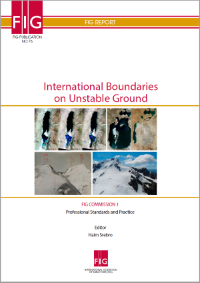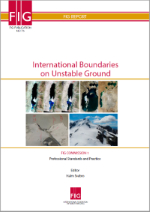News in 2021

|
International Boundaries on Unstable Ground
January 2021
New FIG Publication no 76
Editor: Haim Srebro
Authors: Vincent Belgrave, Andrea Cantile, Donald Grant, William A.
Robertson and Haim Srebro

|
This FIG Publication on
International Boundaries on Unstable Ground is a supplement
and extension to FIG Publication 59 on
International Boundary Making. Publication no. 59 mainly
elaborated on the process of international boundary making with
the specified and important goal to achieve a long lasting
stable agreed boundary line.
IInternational Boundaries on Unstable Ground is a valuable
supplement to promote just, peace and inclusive societies
throughout the world and achieve the United Nations Sustainable
Development Goal No. 16 on Peace, Justice and Strong
Institutions. It is intended to promote the sharing of
methodological knowledge and experience regarding delimitation
of international boundaries and to promote peace throughout the
world.
|
This FIG Publication deals with:
- river boundaries, elaborating on the practical case of the
Jordan and Yarmuk Rivers
- boundaries in lakes and elaborates on the practical case of the
Dead Sea
- The Italian boundaries on melting glaciers and the “moving
border” approach, and
- Issues of instability of boundaries due to tectonic plate
movement, including issues of geodetic reference systems for
boundary documentation.
FIG Publication 76 has been initiated and edited by Dr. Haim Srebro,
who has already developed methodology of a process driven boundary
making model (FIG Publication 59), following almost fifty years of
practical experience in boundary making, including boundary delimitation
in rivers and lakes. The practical part has been prepared by senior
practical professionals, with expertise in boundary delimitation and
demarcation. Three of them served as Director Generals of national
surveying and mapping organizations (Dr. Haim Srebro in Israel and Dr.
Bill Robertson and Prof. Don Grant in New Zealand), one served as chief
geographer (Prof. Andrea Cantile in IGMI Italy), and one served as chief
surveyor in UN international boundary missions (Vince Belgrave).
In his preface FIG President Rudolf Staiger writes:
"Borders", "demarcation lines" or "frontiers" are on one hand
evoking negative associations like separation and segregation. But on
the other hand they also serve for good being often the basement of a
peaceful and life together with our neighbours. In the latter sense each
borderline is also an important element of a prosperous coexistence. The
legal act of establishment and recognition of borders between private
properties is normally regulated in the national law based on a common
understanding and on one constitution.
Defining, establishing and maintaining international boundaries
is a very demanding task. The underlying legal framework is more
complex. Several states with different constitutions and varying legal
opinions are involved. International agreements are the base for the
recognition of a border between two or more states.
FIG thanks the authors for their valuable contribution as
international experts of boundary-makers. We hope that this publication
will be an informative guide for the definition of future international
borders.
Louise Friis-Hansen
11 January 2021

























